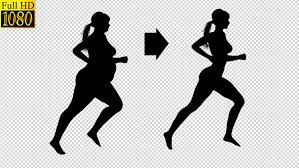I have news for you, there’s no such thing as a “runner’s body”. Becoming a runner happens in the mind. And just because you might not look like a leopard when you’re out there tracking your distance, doesn’t mean you’re not a runner. Running is a great way to improve your fitness, build endurance, and can boost weight loss if that’s what you’re looking for. There are a few things to be aware of to reduce your risk of injury and get the most out of your workouts. We’ve put together the most important fitness and nutrition tips for you below.
FITNESS TIPS FOR RUNNING WHEN OVERWEIGHT
START SLOWLY
If you’re a beginner runner, your muscles, tendons, and joints are being challenged in a new, unfamiliar way. The heavier you are, the greater the load is for your body. That’s why it’s important to start out slowly and be patient with yourself in order to prevent any signs of overtraining.
Since the impact force of running is two to three times as high as walking, it is healthier to start building endurance through walking first. Begin with 15 minutes (about 3 times a week) and increase the amount in the first 2-3 weeks. Depending on how strong you feel, you can gradually increase to a combination of walking and jogging (example: 30 sec. running + 2 min. walking, repeat 3-5 times per session). When this feels easy, increase to 3 minutes of running or do more repetitions. Don’t forget to stretch after your run/walk.
FOCUS ON LOW TO MEDIUM INTENSITY RUNS
When you start your fitness training, focus on easy runs (intensity level less than 75%) and moderate-intensity runs (75-80% intensity). A slower pace reduces the loading force and thus the strain on your tendons, muscles, and joints. If you can carry on a conversation when you run, you’re in the right range. If you are running to lose weight, this kind of easy run is an effective way to reach your goal because it boosts your metabolism.
Running on soft surfaces, such as forest trails, can ease the impact on your joints. The flatter the surface, the better; roots, gravel, and ditches make running more challenging when you’re starting out because you have to concentrate on keeping your balance and protecting your joints. An even surface allows you to run with a more relaxed and steady stride. Try to keep your steps shorter and avoid overextending your legs.
START WITH COMFORTABLE GEAR
The right running shoes are important for your comfort and safety. Choose shoes with good cushioning to absorb shock. Talk to a running shoe professional and try a test run. Proper clothing is also important; if you sweat easily, choose breathable material to keep you comfortable while you run.
DON’T OVERDO IT: INCREASE GRADUALLY
The intensity of your workouts should increase slowly and gradually if you’re running when overweight. Give your body enough time to get used to the strain of working out. When your body feels good during and after your runs, you can gradually increase the scope. The ideal running schedule to build a solid base is three times a week for about 30 minutes. Don’t increase the intensity of your runs until you can run for 30 minutes easily. At this point, you can start introducing slower and faster stretches in your run.
BEFORE YOUR RUN
Don’t start your run on an empty stomach or when you’re hungry. Have a small snack 30 to 60 minutes before your run to energize you. A banana or a small granola bar is a good pre-run snack. Steer clear of foods that are high in fiber (e.g. legumes, whole grain products). Although these foods are an important part of your diet, don’t eat them before a workout. They are hard to digest and can lead to discomfort when you run. Foods high in fat can also cause cramping.
Drink a glass of water before you lace up your running shoes, but don’t drink so much that it sloshes around in your stomach.
DURING YOUR RUN
If you get thirsty while you’re running, take a water bottle with you. Sports drinks or watered-down fruit juice is only recommended if you’re an intermediate runner training hard for more than an hour.
Do you get dizzy when you work out? You might be dehydrated or need a bigger snack before your run. Listen to your body. If you experience frequent episodes of dizziness, talk to your doctor.
AFTER YOUR RUN
Did you just finish a run? Great, you should be proud of yourself! Eat a snack within an hour after your workout (composed mainly of carbohydrates and protein) to refill your glycogen stores and support recovery. A larger meal is only recommended if you ran more than an hour or your last meal was a long time ago.
- Plain yogurt/soy yogurt with fresh fruit and a small handful of nuts
- Omelette with vegetables and a slice of whole grain bread
- Smoothie with berries, milk/soy milk, and a spoonful of nut butter or flax/chia seeds
- Oatmeal with a splash of milk/soy milk, fresh fruit, and a small handful of nuts or nut butter
How to avoid overeating after a run:
- Eat regular, balanced meals (protein at every meal, sufficient fiber, healthy fats)
- Don’t skip meals to cut calories (less is not always more)
- Drink plenty of water
Learn from Professionals
Click here to get a great resource to improve your running experience
Disclaimer:
This post contains affiliate links which means I may receive a small commission if you purchase using that link at no extra cost to you. and if you do, I appreciate you!



